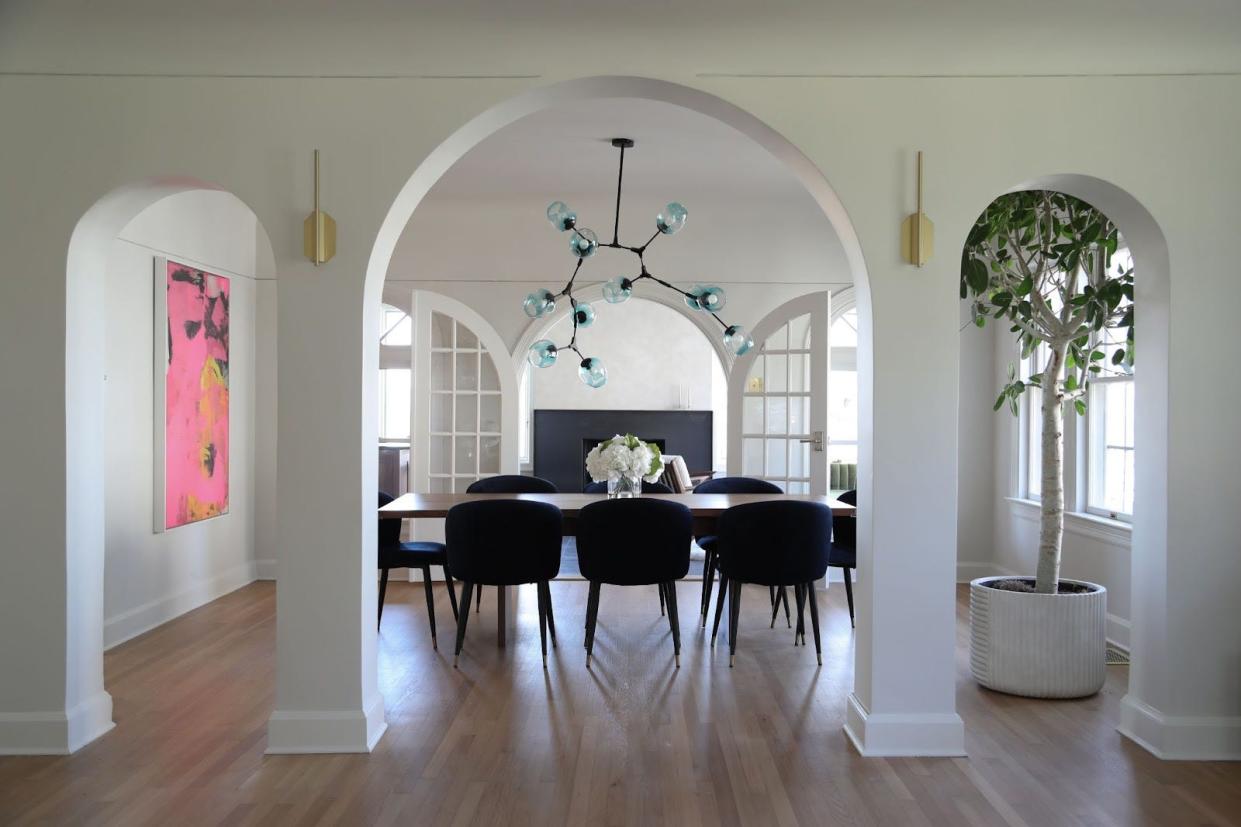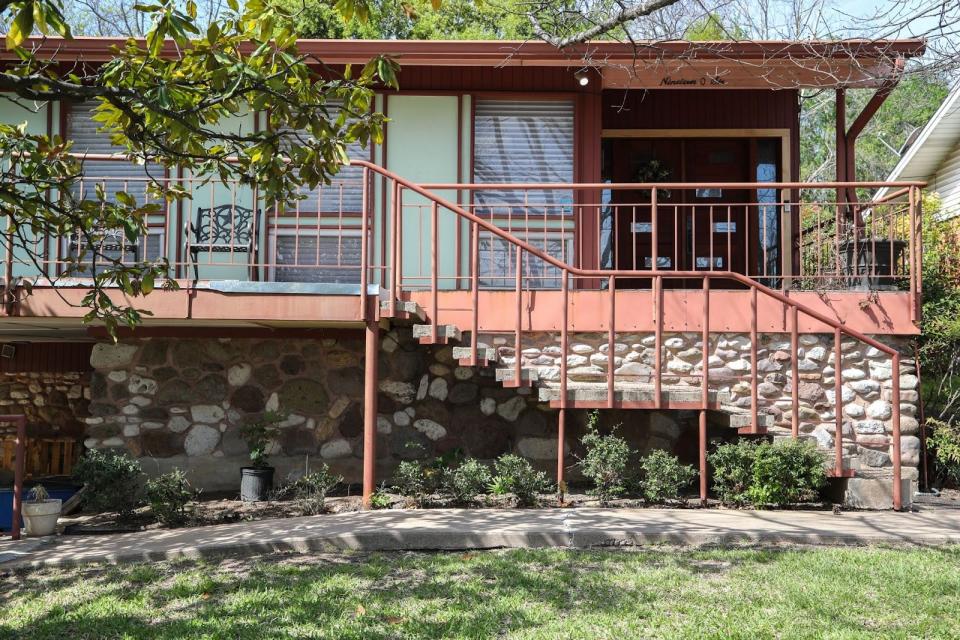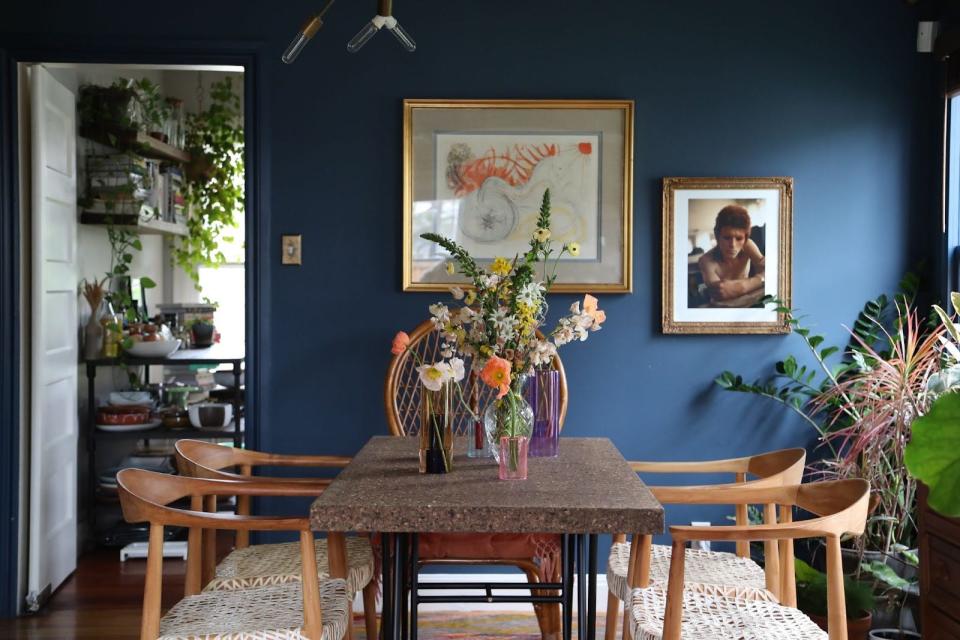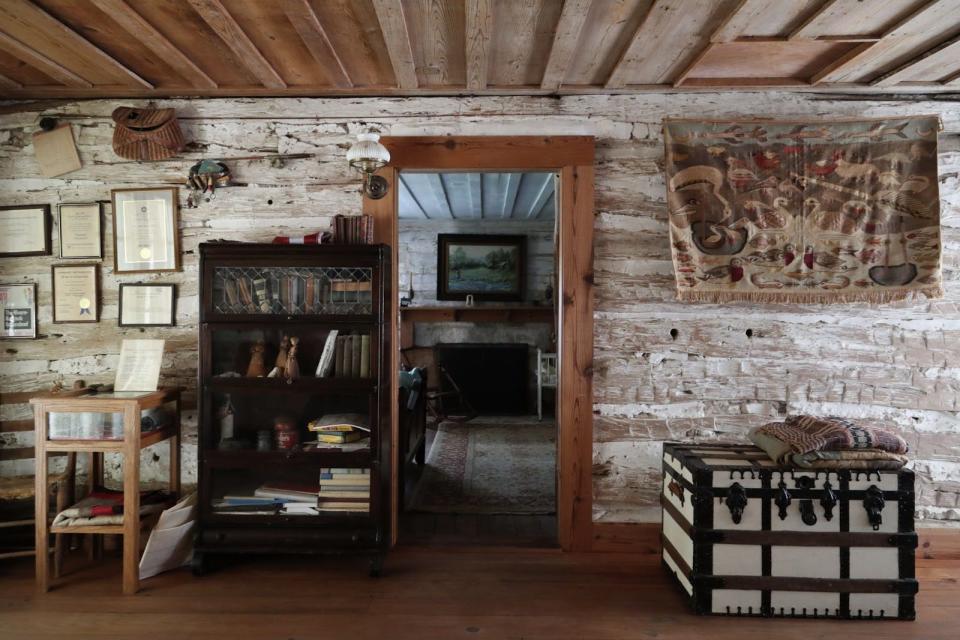Living past and present: Austin home tour showcases 10 houses from the 1840s to the 1960s

Visualize how people nestled inside their domestic spaces over the course of the past 180 or so years in Austin.
Consider how other people in Austin now live in those very same houses.
This duality lies the heart of the 2024 Preservation Austin Homes Tour, which spins out Saturday and Sunday in several historic neighborhoods.
Instead of focusing on one style, district, usage or historical period, this time Preservation Austin, which turns 71 this year, has chosen 10 homes to represent that date from the 1840s to the 1960s.
Basically, that means taking a fanciful journey from a complex of rough log structures to individual high-style midcentury modern masterpieces.
More: Preservation Austin spring tour is not about homes this time
In addition, one can witness how today's householders have adapted these old spaces for use in today's world.
This time, the nonprofit champion of the city's material past has split the tour into two, meaning one can see five homes on Saturday and five on Sunday.
In addition, Preservation Austin plans a block party in the historic Rogers-Washington-Holy Cross Historic District for noon to 4 p.m. Saturday. It's a good way to learn more about this nexus of Black professionals in East Austin, which, for decades, was a powerhouse of community belonging and activism.
For more information, go to preservationaustin.org

Five historic homes for your inspection on Saturday
Note: In these summaries, based on Preservation Austin materials, the names streets are listed, in part to give one a sense of the neighborhoods, but not the addresses or names of the homeowners, for privacy reasons.

Alta Vista Avenue: This one is a looker. I'm not usually drawn to American Colonial Revival, especially in Texas, where the style can feel out of place. Yet I walk by this 1930s specimen regularly and always smile when I spy the extruded “weeping” mortar joints on the buff-colored bricks and the sensitive landscaping that complements its somewhat formal design. Prolific architect Edwin Kreisle imagined this beauty, while the team of Clayton Korte, Skelly Build and Acton Partners helped the current homeowners update it with whimsical touches. Originally built for Alden and Mabel Davis, is often called the “Mabel Davis House” in honor of the civic leader who championed parks, gardening, arts and healthcare causes. The Zilker Rose Garden and Mabel Davis Park are named in her honor. Would love to know more about Davis.
Balcones Drive: Some of the best examples of the midcentury modern style in Austin can be found on — or near — Balcones Drive. Thank goodness that today's home buyers frequently realize that these treasures are much more than elevated ranch-style houses. The current homeowners knew better and saved this 1957 gem from demolition. Nestled among the trees on a slanting lot, the home was designed by prominent architects at Emil Niggli & Barton D. Riley and built by Douglas H. Hicks, who, two years later, sold to a pair of educators who fell in love with its expanses of glass. Like many homes of this era, the footprint is surprisingly small. Yet the owners kept the scale and features such as terrazzo floors, wood paneling, clerestory windows and a concrete block fireplace.
Givens Avenue: Because segregation limited the potential places where African Americans could build houses until housing laws changed in 1968, the Rogers-Washington-Holy Cross Historic District in East Austin combines the feels of the central city and suburbs. It is now receiving the respect it so richly deserves. Austin educators T.C. and Thelma Calhoun were among the founding homeowners here and their warm jewel of a home on Givens Avenue remains in the family.
Maple Avenue: I love this house. It reminds me of a lovely afternoon I spent there with Irene Hill Thompson, longtime civic leader and school secretary at segregated L.C. Anderson High School, not long before her death. Pioneering architect John S. Chase, the first Black graduate from the University of Texas School of Architecture and the first Black architect licensed by the State of Texas, designed this for Thompson soon after the death of her husband Oscar, a friend of Chase's. A symphony of stone, glass, unexpected spaces and wood paneling under a cantilevered flat roof, this house, too, remains in the family.
Breeze Terrace: The Cherrywood neighborhood is home to batches of endearing midcentury homes that don't fit into the high designs of those in some West Austin districts. This 1946 example is modest, compact, traditional and minimal, meant for a generation of World War II veterans and their young families. Its current owner has turned it into a stylish haven in a close-knit East Austin community. In 2020, Forge Craft Architecture + Design designed additions that make the place even more delightful.
More: Indianola a hotspot for Texas history buffs
Five historic homes for your pleasure on Sunday

East 10th Street: During the late 19th century, a thin ring of Victorian houses circled Central Austin neighborhoods — north, south, east and west. This one is in East Austin. "From the street, a passerby might never realize that this lovely Vernacular Victorian home contains a delightful architectural idiosyncrasy," reads the Preservation Austin materials on the Depew-Cherico-Frazier House on East 10th Street. "Constructed circa 1887, the dwelling is clad in cedar shiplap siding and features a beautifully restored full-width porch complete with turnpost columns and upper trim spindles. However, for this home, one lovely front porch was not enough!" In 1997, the current homeowners saved a nearby historic home from demolition, "moved it to the property, and attached it to the rear of their home, creating an utterly unique 'two-faced' residence with a pair of front porches, one facing forward and one facing back."
Avenue H: If you've lived in Austin a minute, you know that the Hyde Park area is packed with historic homes shaded by ancient trees on calm, wide streets. This recently restored 1925 Craftsman-style bungalow is surrounded by Tudor Revival houses in the Shadow Lawn Historic District. Its original owners bought the lot from the company owned by Monroe Shipe, the developer of Hyde Park and namesake for Shipe Park. In the 1960s, it was purchased by a member of a prominent Lebanese American family, whose sisters moved in nearby. The current owners hired StudioHA Architecture to complete a full renovation of the property.
La Ronde Street: Just as Austin is graced with a ring of Victorian homes — and another of houses belonging to the bungalow family — one can easily trace a ring of postwar modernist architecture on a city map. This sample sits in a cul-de-sac developed by famed architect Herbert C. Crume, who built his own home here. "A renovation by Cuppett Kilpatrick Architects reconfigured the home’s kitchen, entry, and bathrooms, but retained essential midcentury modern elements like the freestanding brick fireplace, plywood paneling, and open, light-filled spaces accented by cool modern tones," reads the tour materials. "The exterior of the home remains unchanged — still a gem in the crown of Crume designs — and is defined by a classic modern profile, characterized by a graceful low-sloped roofline, an attached carport and original floor-to-ceiling aluminum window walls."
Sinclair Avenue: If you have never visited the Moore-Hancock Homestead, you are in for a treat. The log structures, the earliest likely built in the late 1840s, are tucked into the post-World War II Rosedale neighborhood. Irish-born settlers built the homestead using cedar logs and rafters interlocked with half-dovetail notches without using any nails. Judge John Hancock purchased it in 1866. Orange Hancock, formerly enslaved by the judge and probably his half-brother, later lived here with his family for many years, which offers insights into Austin during the Reconstruction Era. In the late 1980s, the buildings were condemned and almost demolished. The couple that bought it not only completed a careful restoration, they excavated the site and uncovered thousands of artifacts, all the while living there.
Bluebonnet Lane: Just as the Moore-Hancock House is a revelation in the Rosedale neighborhood, this American Foursquare-style home stands out in the Zilker District of South Austin. More than 100 years ago, it was built for the Von Rosenburg family, descendants of German pioneers, beyond of Austin’s city limits on a large plot that was later subdivided. (One of the pedestrian delights of Austin is to stumble on these rural remnants; the clue is often the size or shape of the lot.) "Today, the house has been restored to a single-family home though it still bears myriad layers of history," tour materials read, "including remnant quirks of the duplex remodel and even 100-year-old features like wood windows, oak floors and longleaf pine crown molding and wainscoting."
This article originally appeared on Austin American-Statesman: Follow city history through the 2024 Preservation Austin Homes Tour

